“Titanium is widely used metal across industries from aerospace to jewelry. In fact, it is the ninth most abundant element on Earth. Yet, its tendency to dull necessitates regular polishing to retain its aesthetic and functional appeal. Here comes the role of titanium polish in addressing this issue from day one.”
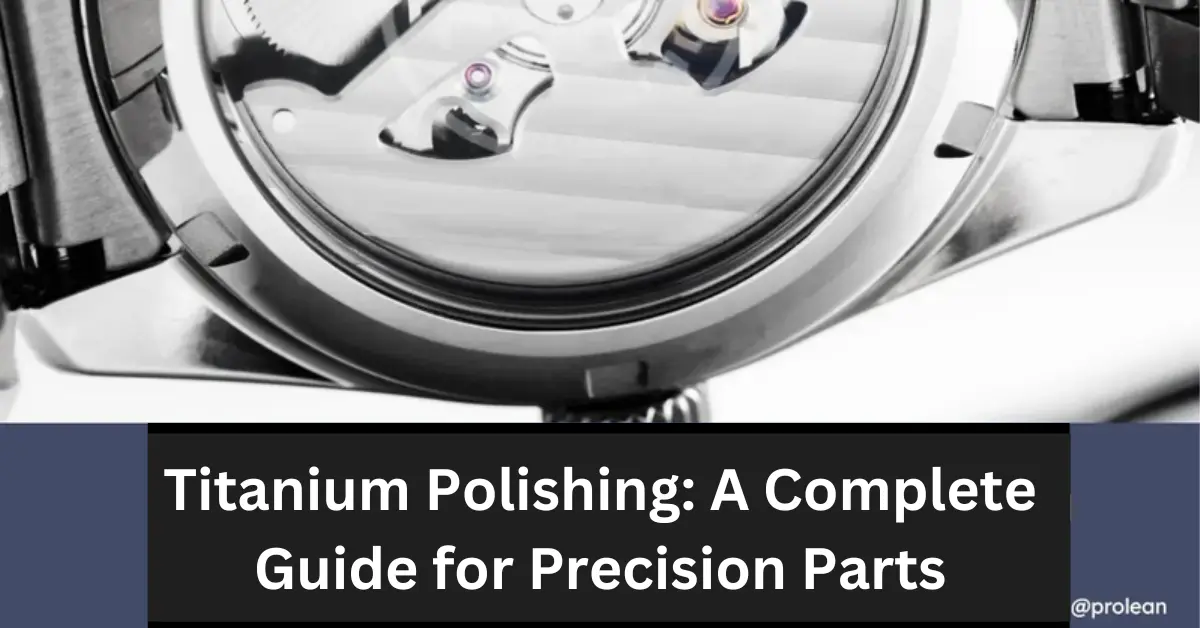
Titanium polishing is refining the metal’s surface to achieve a smooth, mirror-like finish that enhances its functionality and visual appeal. In high-precision industries such as aerospace, medical, and automotive manufacturing, polished titanium improves component performance, longevity, and corrosion resistance.
A flawlessly polished surface reduces friction, enhances electrical conductivity, and ensures easy sterilization, making it ideal for critical applications like surgical instruments, engine components, and custom high-end products.
With surface roughness reaching as low as Ra 0.1 µm, polished titanium meets the highest industry standards for precision and durability.
For industry owners looking to elevate their product quality, ProleanTech offers cutting-edge titanium polishing solutions tailored to meet specific industrial needs. Our advanced techniques ensure superior surface finishing that enhances component performance, reduces maintenance costs, and adds a premium touch to your products.
Whether you require medical-grade sterilization, aerospace precision, or luxury-grade aesthetics, ProleanTech guarantees top-tier results with state-of-the-art equipment and expert craftsmanship. Contact us today and experience the next level of titanium finishing for your business success.
Why Do You Need Polish Titanium?
For industry owners, polished titanium isn’t just about aesthetics. It’s a game-changer for performance, durability, and product value. A finely polished titanium surface enhances corrosion resistance, reduces friction, and ensures easier maintenance, making it ideal for aerospace components, medical implants, and high-end consumer products.
By refining the metal to a mirror-like finish, businesses can improve product longevity, reduce operational costs, and enhance customer appeal, ultimately boosting their competitive edge in the market.
At ProleanTech, our experts have mastered the art of titanium polishing to deliver unparalleled precision and quality. Below, we outline the key reasons polishing is essential and how it can optimize your products for maximum efficiency and durability.
Whether aiming for superior hygiene in medical tools, high-performance aerospace parts, or premium-finished consumer goods, ProleanTech ensures your titanium components meet the highest industry standards
1. Physical and Aesthetic Appeal
At its core, the decision to polish titanium often hinges on its visual appeal. Polished titanium surfaces exhibit a smooth, shiny finish. This enhances the product’s overall look and provides a sense of quality.
When consumers or industries see a polished titanium item, they inherently associate it with high-value and superior craftsmanship.
Moreover, titanium may get scratches, smudges, or other imperfections during manufacturing. Polishing effectively mitigates these issues.
Transitioning from a rough, untreated surface to a refined, polished one enhances user experience and makes the product more marketable.
2. Enhanced Corrosion Resistance
Corrosion resistance is one of titanium’s prime features. However, a polished surface further amplifies this trait. Polishing reduces the chances of corrosive agents getting a foothold by removing microscopic imperfections and irregularities. This enhanced resistance can be critical in environments where corrosion can be disastrous, like in marine applications or medical implants.
3. Improved Cleanability and Sterilization
In specific sectors, especially the medical field, the ability to clean and sterilize equipment is paramount. Due to their smoother texture, polished surfaces, are inherently easier to clean.
They provide fewer crevices for hiding dirt, bacteria, or other contaminants. This ensures that medical instruments remain sterile and prolongs the lifespan of devices.
4. Reduction in Friction
Polishing titanium can also lead to a reduction in surface friction. This is particularly useful in applications where parts move against each other. Reduced friction means less wear and tear, ensuring the components have a longer operational life.
5. Increased Electrical Conductivity
Interestingly, polishing can enhance titanium’s electrical conductivity. A smoother surface ensures better contact, especially in connectors and other electrical applications. Although titanium is not primarily used for its conductive properties, improved conductivity can be beneficial in certain scenarios.
Try Prolean Now!
Flawless Titanium Finishing Starts with Proper Surface Preparation
Just like painters emphasize the importance of priming a wall before painting, polishing experts at ProleanTech underline the necessity to prepare titanium adequately. Firstly, surface contaminants can hinder the surface polishing process.
Transitioning to polishing without adequate preparation may lead to uneven finishes and can even damage the material. Secondly, removing impurities ensures better adhesion, especially if any coatings are to be applied later. A variety of contaminants can make their way onto the surface of titanium;
- Oil and Grease: Often stemming from handling or machining processes.
- Oxides and Scales: Arising from high-temperature operations like welding or forging.
- Dirt and Dust: Environmental factors or storage conditions can lead to these.
- Residues from Previous Processes include old paint, coatings, or chemical residues.
The first step in preparation usually involves an initial cleaning. This step aims to remove bulk contaminants. Mild soapy water, combined with a soft brush, works efficiently.
Additionally, solvents like acetone can be used to dissolve grease and oil. However, care should be taken to ensure complete evaporation of solvents, as any residue might interfere with subsequent processes.
Select the Best Cleaning Method for Mirror-Like Titanium Finishing
For industry owners and manufacturers, choosing the correct cleaning method is crucial to achieving a flawless titanium finish. Different cleaning techniques are available depending on the type of contaminants present and the specific requirements of your parts.
Whether you need to remove heavy oxides, machining residues, or surface impurities, selecting the right approach ensures a smooth, defect-free surface that enhances polishing quality and overall product performance.
Below, our experts outline the best cleaning methods to prepare your titanium components for a premium finish.
-
Mechanical Cleaning Techniques
After initial cleaning, one might still encounter stubborn contaminants. For these, mechanical methods prove beneficial. Sandblasting or abrasive blasting can remove scales or heavy oxide layers.
This technique uses a high-pressure stream of abrasive material to clean the surface. Another method is wire brushing, especially for tight spaces or intricate designs. The goal is to ensure the surface is free from foreign material that could compromise the polishing result.
-
Chemical Cleaning Methods
Chemical methods might be more effective for specific contaminants, especially microscopic ones. Acid cleaning, also known as pickling, is one such method.
Many impurities can be dissolved by immersing the titanium piece in a nitric and hydrofluoric acid mixture. However, it’s essential to monitor the process closely. Overexposure can lead to excessive material removal.
Table: Common Acid Cleaning Mixtures for Titanium
| Acid Combination | Concentration | Application |
|---|---|---|
| Nitric & Hydrofluoric Acid | 20% Nitric, 2% Hydrofluoric | General Cleaning |
| Nitric & Hydrofluoric Acid | 30% Nitric, 5% Hydrofluoric | Heavy Oxide Removal |
(Note: Ensure the titanium is thoroughly rinsed after chemical cleaning. Residual acids can lead to corrosion or discolouration.)
A visual inspection is always recommended after cleaning. The aim is to ascertain that the titanium surface is impeccably clean and ready for the subsequent metal polishing phase. The magnifying lens or microscope can help detect any remaining imperfections. Advanced techniques like electron microscopy are ideal for inspections in some high-precision industries.
Progressive Sanding: The Key to a Perfectly Smooth Mirror-Like Titanium Surface
Progressive sanding is a crucial preparatory step in the titanium finishing process, applied after thoroughly cleaning the surface. This multi-stage technique involves using sandpapers with progressively finer grits to gradually refine the titanium’s texture, eliminating surface imperfections, machining marks, and micro-scratches.
By systematically smoothing the surface, progressive sanding ensures better adhesion for coatings, enhances the effectiveness of buffing and polishing, and ultimately contributes to a flawless, high-performance finish.
For industries requiring precision-engineered titanium parts, such as aerospace, medical, and high-end manufacturing. Progressive sanding is essential for achieving uniform surface quality, reduced friction, and enhanced durability. Skipping this step can result in inconsistent polishing results, reducing both the aesthetic appeal and functional integrity of titanium components.
Here’s an in-depth exploration of this technique:
1. Start with 220 Grit Sand Paper
Starting the polishing process with 220-grit sandpaper might seem coarse, especially when you desire a mirror finish. Nonetheless, this step is crucial for several reasons: The 220-grit sandpaper efficiently removes any superficial irregularities, scratches, or imperfections on the titanium surface, forming a solid foundation for the subsequent sanding steps.
Applying consistent pressure and maintaining a steady hand is paramount during this initial phase. Moreover, always move in one direction to prevent cross-scratching.
2. Progress to 800 Grit
Transitioning from 220 to 800 grit signifies a significant jump. At this point, you’re not looking to remove material but to refine your work so far. The 800-grit sandpaper takes on the following roles:
- It refines the scratches made by the 220 grit, making them less visible and more shallow.
- The process ensures that the surface is prepared adequately for the next and finer grit stage, creating a smoother substrate.
- By the time you finish the 800 grit, the titanium’s surface will already exhibit a more refined, albeit matte, appearance.
During this step, it’s crucial to keep the sanding motion consistent. Regularly check the surface for any residual coarse scratches. If they persist, continue sanding until they are adequately addressed.
3. Finally, Use 2000 Grit
This is the step where the magic truly begins to manifest. Using a 2000 grit sandpaper, you’re entering the realm of fine polishing. The 2000 grit will transform the matte surface achieved post-800 grit into a semi-glossy one. Also, excellent abrasive particles in the 2000-grit sandpaper work diligently to eliminate minute scratches, paving the way for a mirror finish.
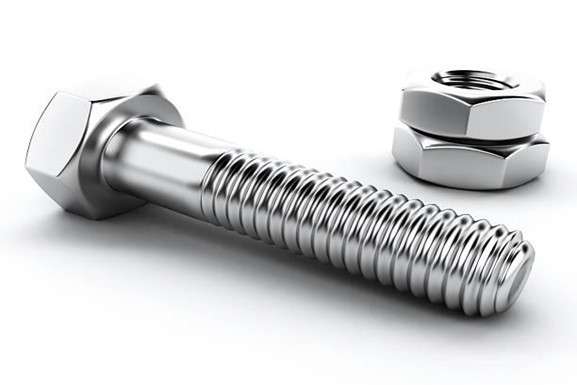
Polished titanium screw & bolt
At this stage, the titanium piece will start reflecting light more uniformly. It’s important to note that patience is a virtue here. Although the 2000-grit sandpaper is fine, working with it requires attention to detail to ensure that the entire surface attains a consistent semi-gloss finish.
Titanium Buffing: Ensure Maximum Shine and Durability for Your Parts
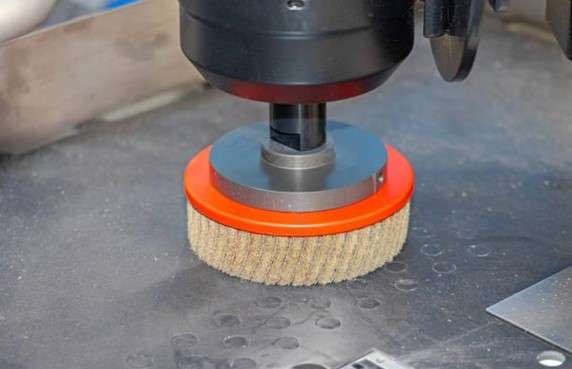
The titanium buffing process
Buffing is a critical finishing process that enhances titanium components’ shine, smoothness, and longevity. Unlike basic polishing, buffing eliminates microscopic surface irregularities while ensuring a uniform reflection of light that creates a high-gloss, premium appearance.
This process is essential for industries where aesthetic perfection and functional performance matter, such as aerospace, medical, and high-end manufacturing.
Once buffed, titanium doesn’t just gleam; it glows, showing its fine workmanship and natural beauty. A benefit not immediately visible is the protective quality of buffing. A buffed surface becomes smooth and offers fewer niches for dirt, moisture, and other agents, reducing the propensity for corrosion.
Materials and Tools Required for Titanium Buffing
Buffing titanium isn’t something you jump into without preparation. Equipping oneself with the appropriate materials and tools is the first step to ensure a satisfactory outcome. Here’s a list of essentials:
-
- Buffing Wheel:
Buffing wheels are primarily crafted from cotton, sisal, or sometimes a combination of these materials. The material choice often dictates the finish of the buffing action and its aggressiveness.
- Buffing Compounds:
Think of these as the “paint” for your “brush” (the buffing wheel). These compounds contain abrasives tailored for buffing processes. Titanium, being hard, demands a more rigid combination, typically those crafted for metals like stainless steel.
- Safety Gear:
Safety is paramount in any process involving machinery and abrasives. Equip yourself with safety goggles to protect your eyes from flying particles.
Gloves will protect your hands from abrasives and offer a better grip. An apron rounds off the protective gear, shielding your attire from compound spatter and dust.
ProleanTech’s experts use the above materials and tools to handle every step with precision, delivering polished parts that meet the highest industry standards.
The Process of Titanium Buffing
Buffing titanium requires a systematic approach to ensure a consistent and polished finish. The procedure involves multiple steps, each crucial for achieving the desired shine. Below is a detailed breakdown of the steps involved in the titanium buffing process:
| SN | Step | Detailed Instructions |
|---|---|---|
| 1 | Machine Setup | Choose a suitable machine, either a dedicated buffing machine or a drill with an attachment. Securely attach the buffing wheel, ensuring no loose connections or potential for wobble. |
| 2 | Compound Application | Start the machine to get the buffing wheel spinning at a steady speed. Press your chosen buffing compound against the spinning wheel until a visible layer is deposited. |
| 3 | Commence Buffing | Securely grip the titanium piece to prevent slippage and apply the amount to the rotating buffing wheel, maintaining steady and even pressure throughout. Next, move the titanium piece systematically across the wheel’s surface, covering all areas. |
| 4 | Inspect and Repeat | Periodically switch off the machine for safety and inspect the titanium’s surface for shine and smoothness. For areas that lack the desired finish, reapply the buffing compound and buff those specific areas again. |
Mirror-like Finish With Titanium Polishing
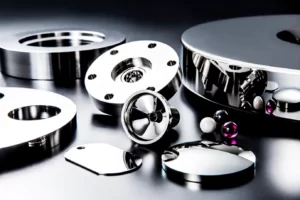
Mirror finish on titanium parts
Achieving a mirror-like finish on titanium is the final brushstrokes. While buffing sets the shine finish, the processes and care taken after buffing amplify that shine and ensure its longevity of a mirror-like finish. Here’s a deeper elaboration into the steps post-buffing that take titanium from simply polished to truly radiant.
- Cleaning Polished Titanium: After buffing, tiny leftovers from the buffing mix and tiny titanium bits might still stick to the metal. A top method to eliminate them is ultrasonic cleaning, using special sound waves in a cleaning mix.It makes sure the metal shines bright. But if you don’t have this tool, no worries. Just use a soft cloth and gentle cleaner to wipe it down. The main goal? Get rid of any leftovers without scratching the metal.
- Checking Every Detail: A strong light can help check if the metal is evenly shiny. If you spot areas that don’t shine as much or have tiny scratches, you might need to do a bit more buffing or use a different polish.
- Keeping That Shine Safe: Once the titanium looks like a mirror, you’ll want to keep it that way. Things like dirt, rough handling, or time can dull that shine. Using a special clear coat that protects shiny surfaces is a good move.This coat is like a see-through guard against anything that can make the metal less shiny. Natural wax is a good backup plan if you’re not into using chemical coats.
- Careful Handling and Storing: How you handle and keep your shiny titanium greatly matters. Touching it with gloves or ensuring your hands are clean is best. When you store it, find a spot that’s dry and not too hot.
Different Grades of Titanium Surface Polishing
Titanium parts can be polished to different surface finishes depending on the polishing speed, force, and type of buffing wheel used. Each level of polishing provides varying degrees of smoothness, reflectivity, and surface quality, making it essential to choose the correct finish based on the application.
Below are the most common titanium polishing grades:
1. Rough Polishing
Rough polishing is the initial stage, where a silicon oxide abrasive buffing wheel and polishing wax are used to remove machining marks, burrs, and sharp edges. This process requires minimal pressure and is ideal for rounding off corners, reducing roughness, and preparing titanium parts for finer polishing stages. While it improves the texture, it does not achieve a high-gloss or refined finish.
2. Medium Polishing
Medium polishing helps refine the surface after rough polishing by reducing visible marks and dull patches. This stage uses aluminum oxide polishing wheels and polish wax, which enhances surface brightness and smoothness.
It creates a semi-gloss finish, making the titanium part appear more uniform while preparing it for finer polishing. This level of finishing is often sufficient for functional parts that do not require high reflectivity but still need a refined, professional look.
3. Fine Polishing
Fine polishing is performed to achieve a highly smooth and semi-reflective surface. It requires using a soft cotton buffing wheel with mirror wax polish, applying increased pressure for more even material removal and greater surface refinement.
This stage eliminates any minor imperfections left from previous polishing steps, making it ideal for titanium components in precision engineering, aerospace, and medical applications where smoothness and reduced friction are crucial.
4. Mirror Polishing
Mirror polishing creates an ultra-reflective, flawless surface that resembles a mirror-like shine. This is achieved using a combed soft cotton buffing wheel and specialized polishing wax, ensuring the titanium surface is entirely smooth and defect-free.
This finish is often used for high-end consumer products, jewelry, luxury automotive parts, and medical implants, where aesthetics, easy cleaning, and corrosion resistance are priorities. Additionally, buffing wheels allow polishing in hard-to-reach areas, ensuring a consistent shine across complex geometries.
Applications of Titanium Polishing
Titanium, renowned for its impressive strength-to-weight ratio and resistance to corrosion, is used extensively in various industries. When polished, titanium’s aesthetic appeal and functional benefits amplify, opening up numerous applications.
This enhances titanium’s appearance and augments its corrosion resistance, making it more suitable for specific tasks and products in numerous sectors.
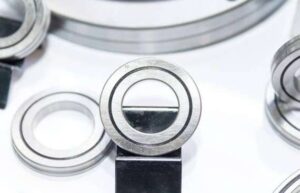
Polished titanium component
The demand for polished titanium stems from its unique combination of beauty and function. From aerospace to jewelry, the shiny finish of polished titanium is not merely about visual appeal. It often critically improves component longevity, hygiene, and performance.
Table: Applications of Titanium Polishing
| Industry | Examples | Why? |
|---|---|---|
| Aerospace | Aircraft frames, Engine parts | Enhanced corrosion resistance; aesthetic considerations in premium aircraft interiors |
| Medical | Surgical instruments, Implants | Hygiene and easy cleaning; corrosion resistance in body-compatible implants |
| Automotive | Car trim, Exhaust systems | Resilience against environmental factors; enhanced aesthetic value |
| Jewelry | Rings, Necklaces | Aesthetic appeal; hypoallergenic properties |
| Marine | Ship hulls, Propellers | Improved resistance against saltwater corrosion |
| Consumer Goods | Watches, Electronic casings | Premium appearance and feel; durability and corrosion resistance in everyday use items |
Polish Your Titanium Parts with Industry-Leading Precision at ProleanTech
At ProleanTech, we specialize in delivering flawless titanium polishing for industries that demand precision, durability, and aesthetics. With years of expertise, state-of-the-art equipment, and a team of skilled professionals, we ensure that every titanium component, a large industrial or a delicate precision piece, achieves a perfect, mirror-like finish.
Our ISO-certified facility meets the highest industry standards, and with 100+ materials in our expertise, we cater to diverse manufacturing needs across aerospace, medical, automotive, and more.
Backed by hundreds of satisfied clients worldwide, we are trusted for our high-precision surface finishing, strict quality control, and commitment to excellence.
Whether you need enhanced corrosion resistance, reduced friction, or a premium aesthetic for your titanium parts, ProleanTech is the perfect partner for your project. Get a quote today and experience the next level of titanium polishing!
Conclusion
Titanium polishing is vital for maintaining titanium components’ appearance and functionality. Whether you’re working with aerospace parts, medical equipment, or jewelry, using the correct polishing techniques and materials to achieve the best results is essential.
By following the proper procedures, you can restore the shine and luster of titanium and ensure that it remains in optimal condition for years to come.
Contact us at ProLean Tech for exceptional Titanium Polishing services that meet industrial standards.
Read more: How Does Polishing Impact Quality Control?
FAQ’s
Why is Titanium So Hard to Polish?
Titanium’s hardness and heat sensitivity make it difficult to polish. It requires specialized techniques to prevent warping and ensure an even finish. We offer expert polishing solutions for a perfect shine.
How to Make Titanium Shiny Again?
Use progressive sanding followed by buffing with a polishing compound. Professional polishing services like ProleanTech ensure maximum shine and durability for a flawless finish.
Can You Buff Out Scratches on the Titanium?
Yes, light scratches can be buffed out with a polishing compound, while deep scratches require sanding before buffing. ProleanTech restores titanium surfaces with precision techniques.
What is the Best Polishing Compound for Titanium?
Diamond-based, aluminum oxide or green rouge compounds work best for a smooth, reflective finish. ProleanTech uses industry-grade compounds for optimal results.
Why is titanium polishing essential in certain industries?
Titanium polishing, especially in sectors like aerospace and medical, ensures an aesthetically pleasing finish and heightened corrosion resistance, leading to longer component lifespans and better overall performance.
How does polished titanium compare to other polished metals in terms of durability and shine?
Titanium boasts a superior strength-to-weight ratio and remarkable corrosion resistance. When polished, its shine rivals that of other metals, while its durability remains superior due to its innate characteristics.
Does polishing give a mirror-like finish on titanium parts?
Yes, polishing titanium can achieve a mirror-like finish. The correct polishing compounds and techniques make titanium’s surface highly reflective. This lustrous shine enhances both the metal’s aesthetic and functional properties.
Are There Any Limitations to Titanium Polishing?
Polishing may not be suitable or effective for all titanium parts, particularly those subject to extreme temperatures or high-stress levels.
Polishing may also be ineffective in cases where the part’s surface has already been compromised by corrosion or other forms of damage. In such cases, additional treatments or repairs may be necessary to restore the part’s durability.




Is there any specifications on how to polish titanium regarding the desired smoothness of titanium surface (Ra value) to be eligible for polishing ? I am waiting for answer. Thank you !
No there is not such specifications, the as-machined finish(0.2 RA approx)
is sufficient for titanium polishing
Do you also provide mirror finish services for decorative titanium parts? I am looking for such services for my start-up??
Yes! we provide mirror finish services for decorative titanium parts. We have professional with decades of experienced in titanium polishing, if you need any consultation before service let us know.
Does Bead-blasting works while preparing the surface for titanium polishing? Could you suggest some recommendations?
Bead-blasting is indeed suitable for preparing titanium surfaces for polishing. It is an effective and gentle technique that cleans and enhances corroded metal, removes imperfections, and can restore the appearance of titanium parts without damaging the material
surely, cleaning before polishing the titanium parts is very important for finished quality. In article, you mentioned chemical cleaning, doesn’t it affect the accuracy since there is potential risk of material degradation from surface?
Yes ! It does affect. If the cleaning agents are too harsh or improperly used, they can corrode or alter the titanium surface, impacting its finish and dimensions. Therefore, careful selection and application of cleaning chemicals are crucial to maintain the precision and integrity of the polished titanium surface.
Great points on titanium polishing and its applications !